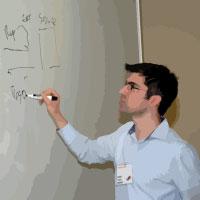
The Daily Texan | By Bobby Blanchard
The Department of Computer Science will decrease the number of required classes needed to obtain a degree from the department, a move some faculty hope will allow students to specialize in their interests and experience more while attending school.
Designed to be more flexible, the new curriculum has been a five-year endeavor by the department to allow students to take more electives. Bruce Porter, department chair of the computer science department, said the average student has time for 15 computer science classes. However, the old curriculum required students to take 11 specific courses to obtain a degree, leaving little time to take upper-division electives. The new curriculum has reduced the number of required courses to six. Porter said some students have jumped to conclusions of the department cutting back the number of required courses for budgetary reasons.
“I cannot think of any way that this has a budgetary side to it at all,” Porter said. “Sure, the department has had budget cuts, we’ve all had budget cuts. But that has nothing to do with the curriculum. This is based on what is best for teaching the field.”
He said the idea of scaling back on required classes to open up more upper-division elective options is taking place at computer science schools across the nation and UT was neither ahead nor behind the trend.
Faculty in the department started talking about revisiting the computer science curriculum in 2007, Porter said. He also said the department took a lot of inspiration from a 2001 report by the Association for Computing Machinery, a national organization dedicated to delivering education resources for computing.
The report, titled “Computing Curricula,” states that the required body of knowledge should be made as small as possible.
“Over the last decade, computer science has expanded to such an extent that it is no longer possible simply to add new topics without taking away,” the report said. “We believe that the best strategic approach is to reduce the number of topics in the required core so that it consists only of those topics for which there is a broad consensus that the topic is essential to undergraduate degrees.”
Porter said the department wanted to change the curriculum because the field has gotten too big to try to teach in four years. Now, Porter said students can study the areas that most interest them in depth.
“For some students, it’s going to be the mathematical stuff, for others it’s going to be game development,” Porter said. “Everybody has their own inclination.”
Although much of the new curriculum has already been implemented over the last couple of years, the most recent and final changes to the curriculum include reducing the number of theory classes. The department previously required four theory classes, but now students only have to take two.
“When you go to four to two, it is not like you can take the content in four courses and squeeze it down to two, because the students aren’t any smarter than they had been before,” Porter said. “Instead you have to choose a little bit of one course and add a little bit of another.”
Before the most recent changes, the department reduced the number of required computer system courses from 12 hours of coursework to eight.
“A problem we had in the past is students would take these four system classes and never really come away with the big picture view of how a computer works,” he said.
Associate computer science professor William Cook said while he did not foresee the department needing to make any additional curriculum changes, adjustments might be needed.
“I do think there will probably be some adjustments to fine tune the current system,” Cook said. “There is a lot of room with flexibility, so if there are any problems we can tweak the curriculum.”
Cook said students in the new theory, systems and programming classes will experience classes taught at a faster pace.
“There could be some struggle there as students adjust,” Cook said. “Essentially we are raising the bar and expecting more of the students.”
Calvin Lin, a computer science professor who chaired a committee that defined a new theory course under the new requirements, said students will find more excitement under the new requirements.
“There is also an observation that our old curriculum, because there was this long chain of required courses, students often didn’t see the pay off, they didn’t see the excitement till a few courses down,” Lin said. “The hope is by shrinking the core they will get to see some of the more exciting things quicker, and this is also an opportunity to bring some of the excitement into the core as well.”
Porter said he was pleased with the curriculum and he did not foresee any more upcoming changes. Nevertheless, he said teaching computer science is a constant struggle.
“There will be a continual battle to keep each of these classes current,” Porter said. “But the overall scaffolding of them, that is going to last us at least 10 years.”



